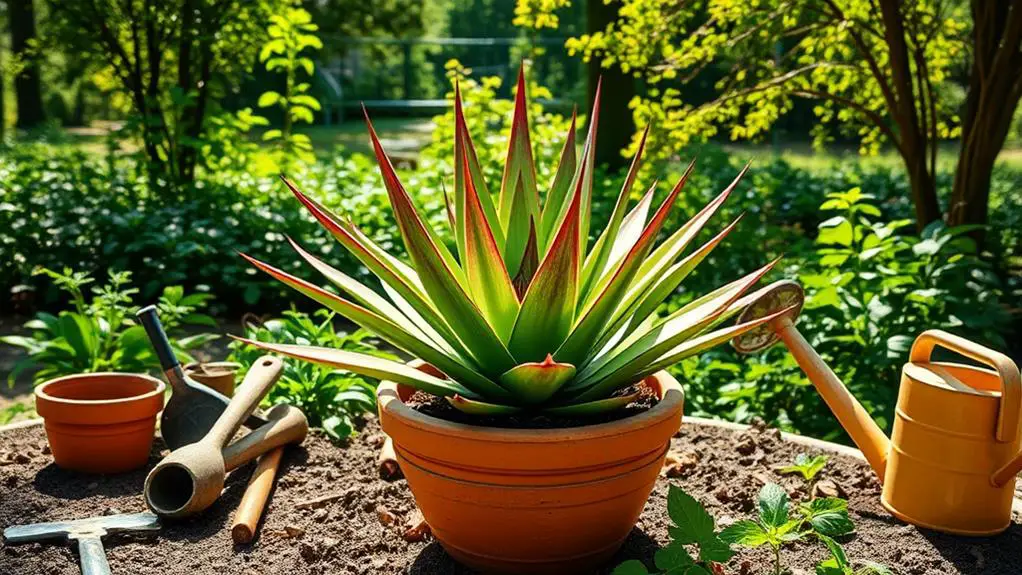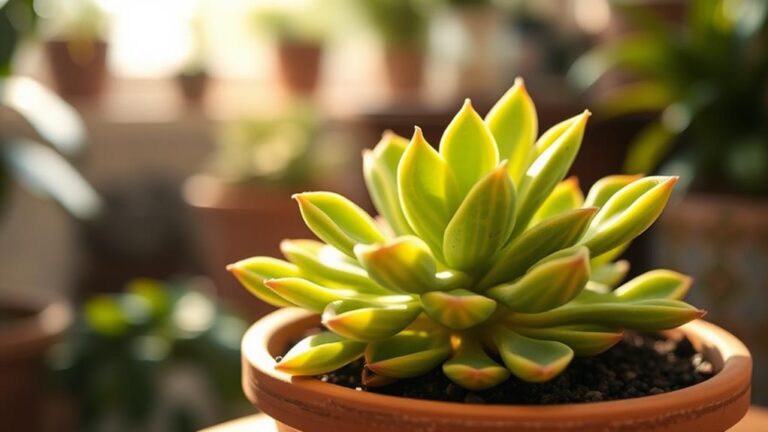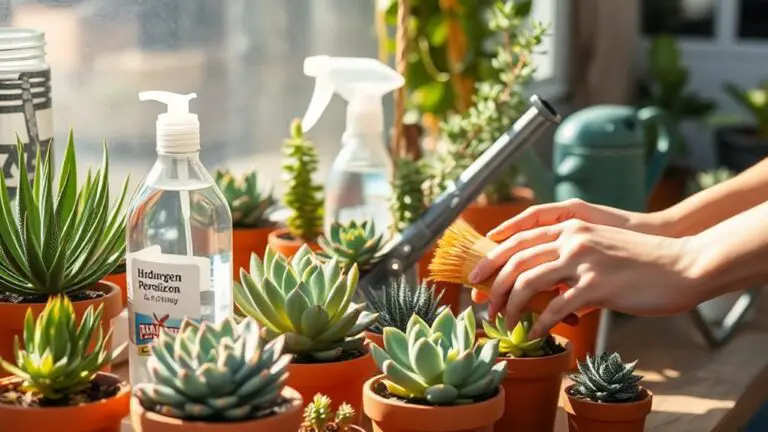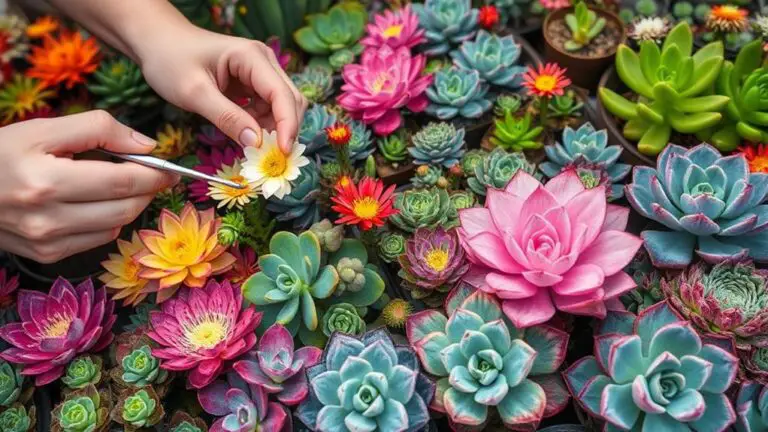10 Essential Tips for Agave Plant Care
Taking care of agave plants might seem straightforward, but there are essential details you need to get right to guarantee they thrive. From choosing the right location to managing pests effectively, each step plays a significant role in the health of your agave. You'll need to understand how much sunlight they require, the type of soil that works best, and how to adjust your care routine with the changing seasons. Ready to reveal the secrets to vibrant, healthy agave plants? Let's start with the basics and build your expertise from there.
Choose the Right Location
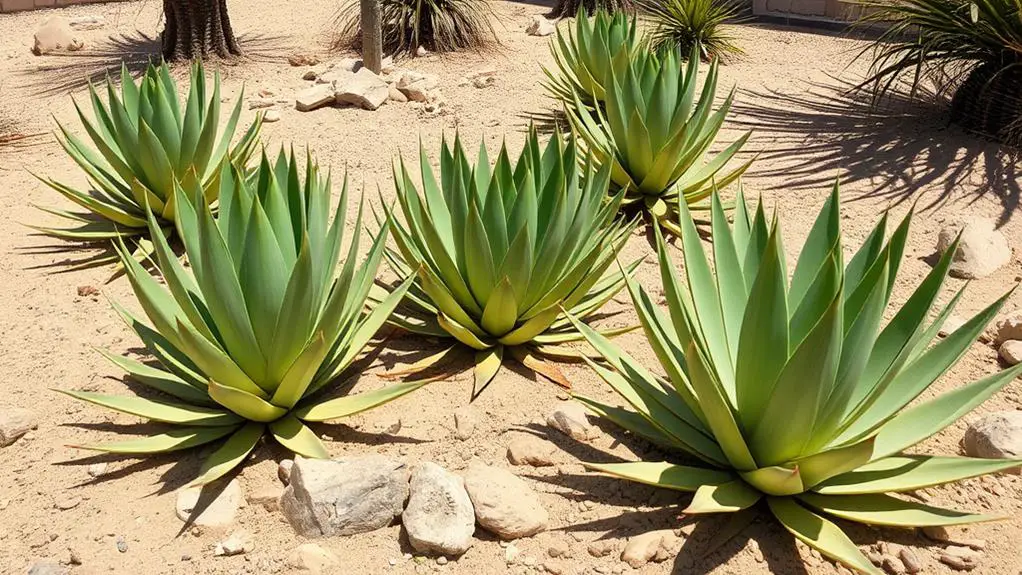
When choosing the right location for your agave plant, assure it gets at least 6 hours of direct sunlight daily to thrive and maintain its vibrant foliage. Agave plants love the sun, so find a spot in your garden that gets plenty of sunlight.
Assure the planting site has well-draining soil, like sandy or rocky conditions, to prevent root rot and promote healthy growth. Agave plants don't like their roots sitting in water, so good drainage is a must.
If you're growing indoor agave, place them near south or west-facing windows. This will maximize sunlight exposure while avoiding cold drafts.
Agave plants prefer dry conditions and can suffer from overwatering, especially in high humidity environments. Good air circulation is essential to help reduce humidity levels around your plant.
When selecting a location, think about the plant's long-term needs. Agave plants grow best when planted in spring or early fall, as extreme temperatures can stress them.
Ensure Full Sun Exposure
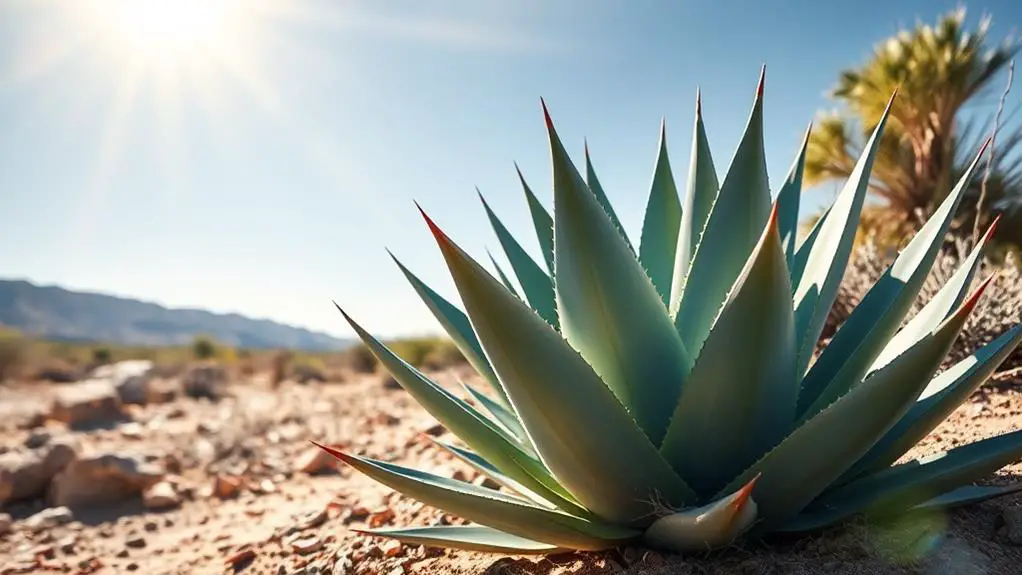
To guarantee your agave plant thrives, give it full sun exposure. Agave plants need at least 6 hours of direct sunlight each day to maintain their vibrant color and health. Full sun helps prevent issues like yellowing leaves, which can happen if your plant doesn't get enough light.
If you're growing agave indoors, place it near south-facing windows, as they provide the most consistent sunlight. West-facing windows can also work, though they mightn't be as effective.
If you find that natural light is inadequate, don't worry. You can use grow lights to make sure your agave gets the light it needs. These lights can supplement the natural light, helping your plant stay healthy and strong.
Consistent exposure to bright sunlight not only supports your agave's growth but also makes it more resilient against pests and diseases. A well-lit environment keeps your plant in top shape, reducing the chances of infestations and other problems.
Use Well-Draining Soil
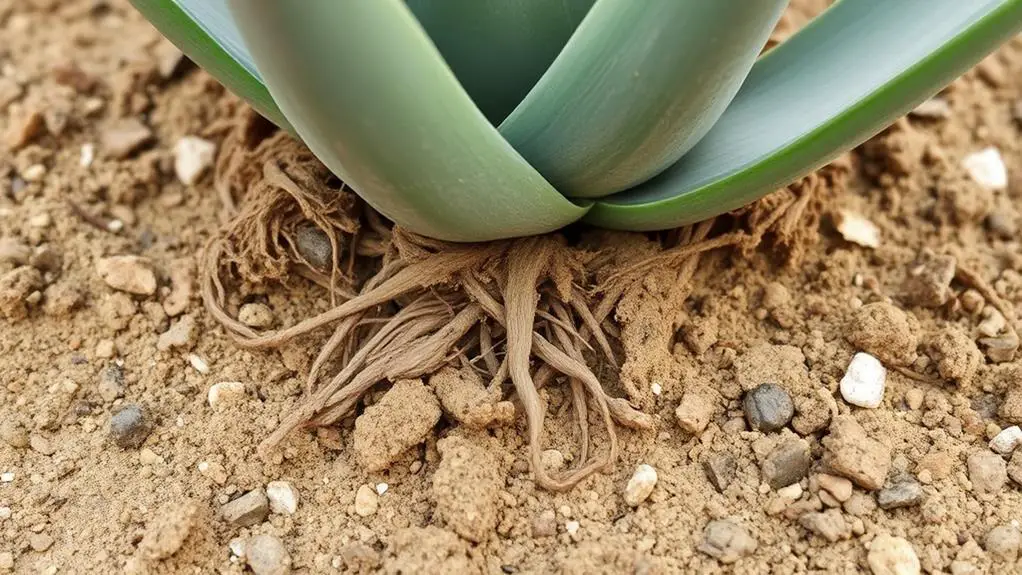
While guaranteeing your agave gets ample sunlight, it's equally important to focus on the type of soil you're using. Agave plants thrive in well-draining soil, which prevents root rot and other issues caused by water retention. A mix of rocky or sandy soil is ideal.
For the finest results, use a potting mix that includes 50% multi-purpose compost and 50% horticultural grit or perlite. This combination guarantees optimal drainage and keeps your agave healthy.
When planting agave, consider incorporating rocks into the planting hole. This helps to enhance drainage and prevent water-logging, which can harm the roots.
If you're growing your agave in a container, make sure the pot has ample drainage holes. These holes facilitate moisture evaporation and maintain healthy root systems by preventing excess water build-up.
Repotting your agave every few years with fresh, well-draining potting mix is also beneficial. Do this during the growing season to refresh the soil quality and promote robust growth.
This practice helps guarantee your agave gets the nutrients it needs while maintaining the right moisture balance. By focusing on well-draining soil, you'll set your agave up for success.
Water Sparingly
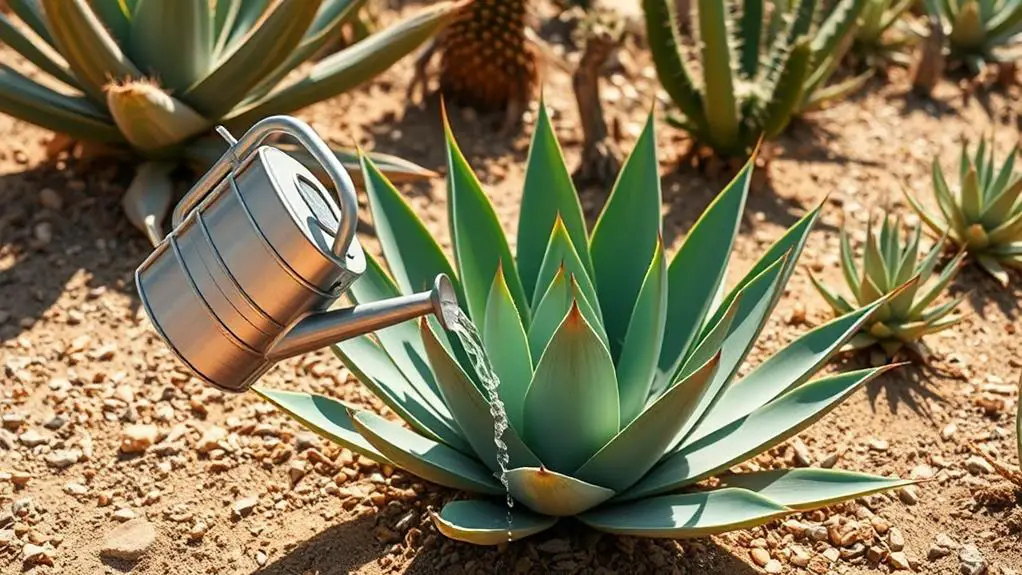
When it comes to watering your agave plant, less is more.
Make sure to water only when the top inch of soil is completely dry to prevent root rot, which can damage your plant.
Using a moisture meter can help you get accurate readings and create a precise watering schedule.
Monitor Soil Moisture
Agave plants thrive when you water them sparingly, keeping soil moisture in check. To keep your agave healthy, it's crucial to monitor soil moisture closely. Agave plants only need watering when the top inch of soil is completely dry. Overwatering can lead to root rot, so always be cautious.
During the growing season, which spans spring and summer, you should water every 2-3 weeks. As winter arrives, reduce this to every 3-4 weeks since the plants enter a dormancy period. Using a moisture meter is a fantastic way to accurately gauge soil moisture levels. This tool helps guarantee that you only water when necessary, avoiding the risk of overwatering.
Agave plants prefer low humidity environments. If you're growing them indoors, make sure to monitor indoor humidity levels. High humidity isn't suitable for agave, so keep the air dry.
Equally important is proper drainage. Always use pots with drainage holes to allow excess water to escape, preventing waterlogging. This helps maintain the right soil moisture and supports healthy growth.
Prevent Root Rot
Preventing root rot is essential for maintaining the health of your agave plants. To water agave correctly, let the top inch of soil dry out completely between waterings. Overwatering is a common cause of root rot, so it's crucial to avoid it.
During the growing season, usually from spring to summer, water your agave every 2-3 weeks. In the winter, when the plant is dormant, reduce the frequency to every 3-4 weeks.
Ensure your agave is planted in a well-draining potting mix designed for succulent plants. This helps prevent waterlogging, which can lead to root rot. If you're using a container, make sure it has ample drainage holes to allow excess water to escape.
Also, monitor for yellow leaves, as they often indicate overwatering and the potential onset of root rot. If you notice yellow leaves, adjust your watering practices immediately.
Agave plants thrive in dry conditions, so avoid placing them in high humidity environments. High humidity can exacerbate the risk of root rot.
Monitor Indoor Conditions
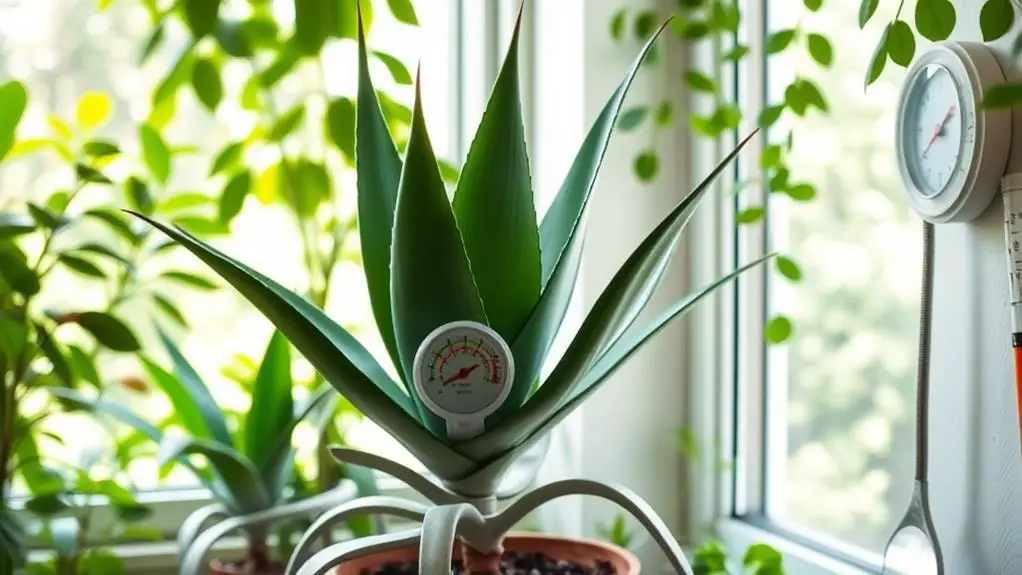
To keep your agave healthy indoors, make sure it gets at least 6 hours of bright sunlight daily, ideally from a south-facing window.
Keep your home's temperature between 65°F and 75°F, and avoid cold drafts.
Use a moisture meter to check the soil and water only when the top inch is dry to prevent root rot.
Ideal Light Placement
For thriving indoor agave plants, guaranteeing they receive ample light is essential. Agave plants need at least six hours of direct sunlight daily for peak growth. Bright, south-facing windows are perfect for meeting these light requirements.
However, west-facing windows can also work well, though you should be cautious of low-light conditions. In low-light settings, agave plants may stretch and grow weak, affecting their overall health.
If your home doesn't have enough natural light, especially during shorter winter days, consider using grow lights to supplement the agave's light requirements. These lights can help maintain a stable environment, guaranteeing your plants get the light they need.
Regularly monitor signs of inadequate lighting. Yellowing or drooping leaves might indicate your agave isn't getting enough light. If you notice these signs, it's time to adjust the plant's location to a brighter spot.
Avoid placing your agave in drafty areas or places with fluctuating temperatures. These conditions can hinder their indoor growth.
Temperature and Humidity
Agave plants thrive best in indoor environments where temperatures hover between 65°F to 75°F (18°C to 24°C). They can tolerate drops to 60°F (15°C) if the change is gradual. It's vital to avoid frost because prolonged cold can seriously harm or even kill your agave plants.
Keep an eye on indoor temperatures to make certain your plants stay within their comfort zone.
Humidity is another significant factor. Agave plants love dry conditions and can suffer from overwatering, especially if indoor humidity is too high. To prevent this, place your agave plants near bright windows, preferably south or west-facing. This location provides them with the necessary light and warmth while helping maintain the dry conditions they crave.
Watch for signs of environmental stress, like yellowing or drooping leaves. These could indicate that your agave plants are struggling with the current temperature or humidity levels.
Regularly monitoring these conditions in your home will help keep your agave plants healthy and happy. By understanding and adjusting indoor temperatures and humidity, you can create the perfect environment for your agave plants to thrive.
Moisture and Drainage
Maintaining proper moisture and drainage is essential for the health of your agave plants. Agave plants thrive in well-draining soil, which helps prevent root rot. Using a cactus potting mix is ideal, and make certain your containers have ample drainage holes. This allows excess water to escape, keeping the roots dry and healthy.
Here are three key steps to manage moisture and drainage for indoor agaves:
- Monitor Soil Moisture Levels: Only water your agave when the top inch of soil is completely dry. This usually means watering every 2-3 weeks during the growing season. Using a moisture meter can help you accurately gauge when it's time to water.
- Control Humidity: Agave plants prefer dry conditions, so keep them away from areas with high humidity, like bathrooms. During winter dormancy, reduce watering even further to adapt to their lower moisture needs.
- Prevent Root Rot: Ascertain you're using well-draining soil and containers with drainage holes. This setup stops water from pooling around the roots, which could lead to root rot.
Protect From Frost
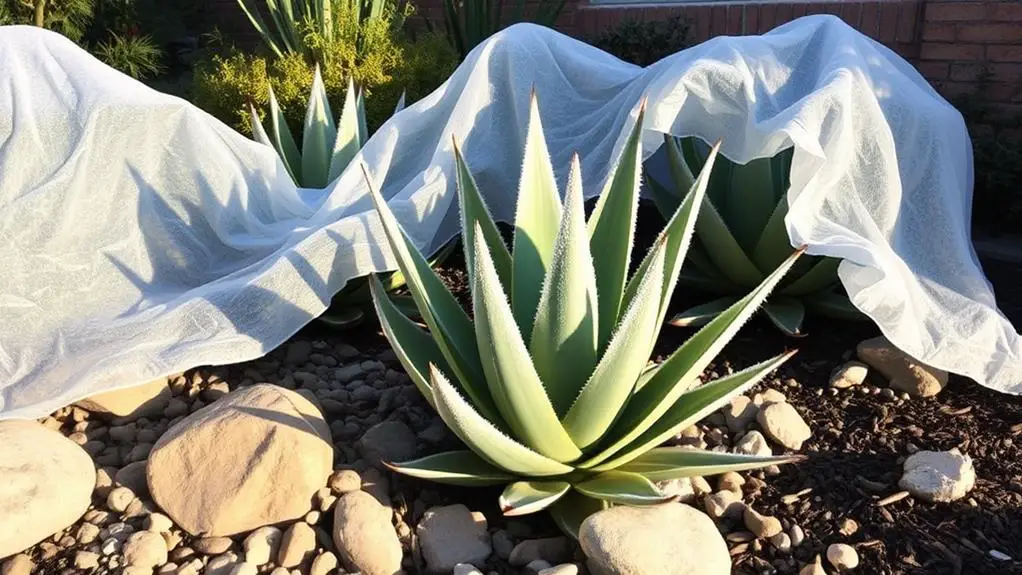
Shielding your agave plants from frost is vital to their survival in colder climates. As part of good agave plant care, you need to protect them when temperatures drop below 32°F (0°C).
Start by monitoring local weather forecasts, especially in late fall and early spring, for unexpected cold snaps. This helps you prepare in advance and take necessary actions.
When frost is predicted, cover your agave plants with frost cloths to protect them from the cold. Place your outdoor agaves in a sheltered location, like against a south-facing wall, to shield them from harsh winter winds and frost.
Another effective method is mulching around the base of the plants. Mulching helps insulate the roots and retain heat during colder months.
For container-grown agaves, it's essential to relocate them to a garage, shed, or any indoor space during extreme cold spells. This guarantees they stay warm and safe.
Repot Regularly
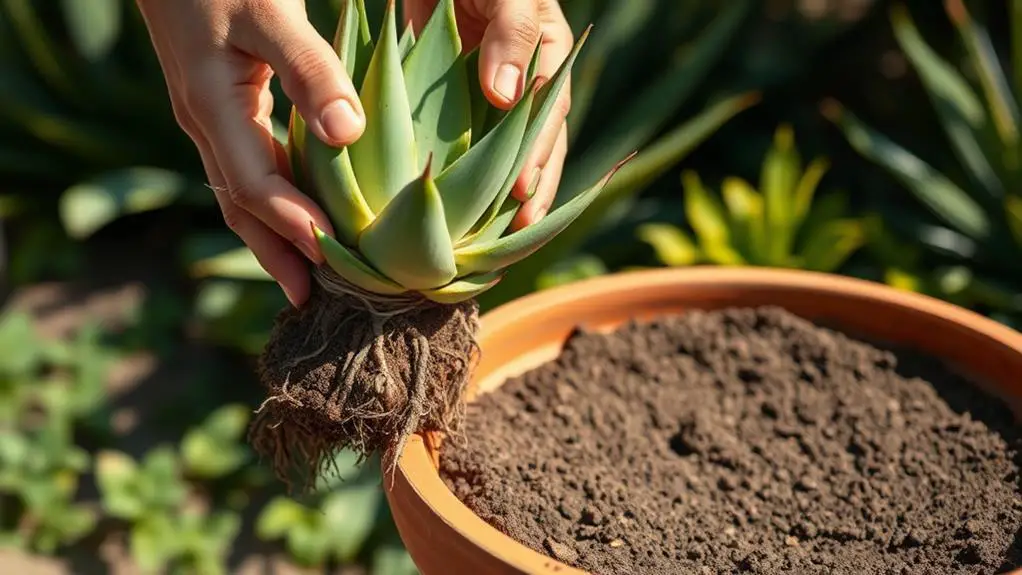
While protecting your agave plants from frost is important for their survival, regular repotting guarantees they continue to thrive year-round.
Repotting your agave every 2-3 years or when they become root-bound makes certain they've access to fresh nutrients and maintain healthy growth.
Here's how to do it effectively:
- Choose the Right Pot: Select a slightly larger pot with good drainage to accommodate your agave's shallow roots. This helps prevent waterlogging, which can cause root rot.
- Use the Right Potting Mix: A well-draining potting mix is vital. Mix 50% multi-purpose compost with 50% horticultural grit or perlite to create the perfect environment for your agave.
- Repot During Active Growth: Performing repotting in the spring or summer, during the plant's active growth phase, guarantees ideal recovery.
Keep the planting depth and direction the same to reduce stress and promote plant stability.
Manage Pests Effectively
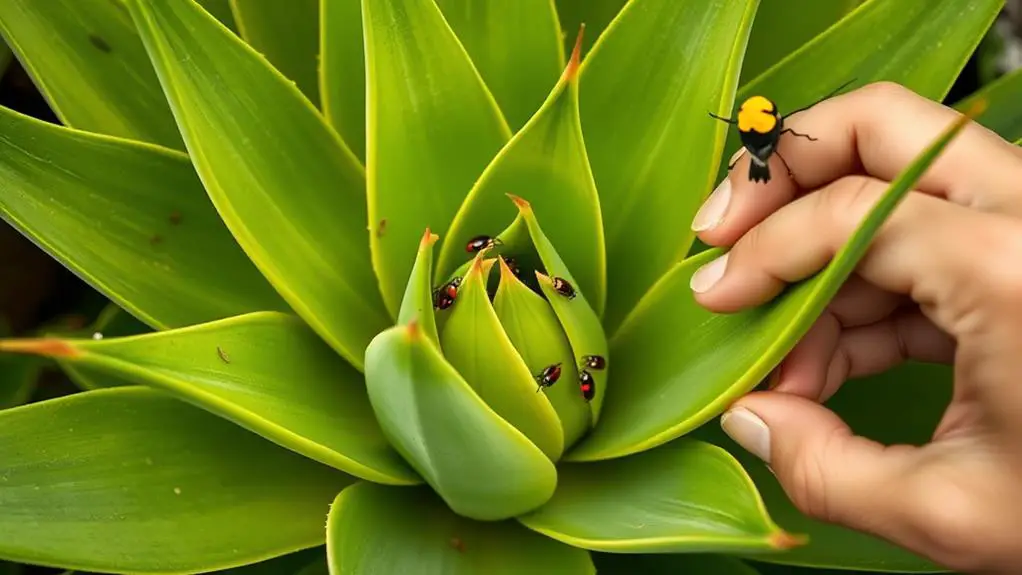
Keeping your agave plants healthy requires vigilance, especially when it comes to managing pests effectively. Regularly inspect your plants for signs of pests and diseases, such as drooping leaves or yellowing, which may indicate issues with pests like the agave snout weevil or mealybugs. Early detection is essential, so promptly remove infested plants to prevent pests from spreading to healthy specimens.
For minor infestations, you can manually remove pests by hand or use insecticidal soap to effectively treat mealybugs and scale insects. Monitor soil moisture levels closely, as overwatering can lead to fungal diseases like root rot, which can further weaken plants and make them more susceptible to pests.
Implement preventative measures to keep your agave plants healthy, such as ensuring proper drainage and maintaining ideal sunlight exposure. These steps will make your plants less prone to pest infestations.
Here's a quick reference table:
| Step | Action |
|---|---|
| Inspect Your Plants | Look for drooping leaves or yellowing |
| Remove Infested Plants | Prevent pests from spreading |
| Proper Drainage & Sunlight | Keep plants healthy to avoid infestations |
Handle With Care
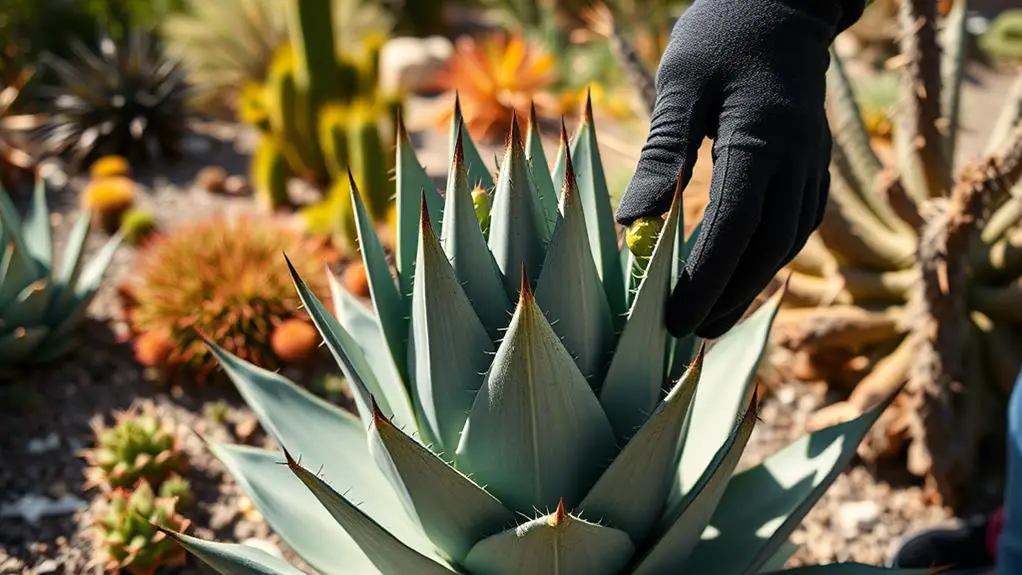
Managing pests effectively is just one aspect of maintaining healthy agave plants. You also need to handle them with care, especially because of their sharp spines. These spines can cause injury, so always wear gloves when pruning or moving your agave.
Pruning is essential to keep your agave healthy. Use clean, sharp tools to make smooth cuts that heal quickly and prevent disease. Be careful with raw agave sap, as it's toxic to humans and pets. Wash your hands thoroughly if you come into contact with it.
When propagating pups, allow the cut roots to callus for a few days in a shaded area. This helps minimize the risk of rot.
Moving potted agaves requires attention to their drainage needs. Verify the pot has ample drainage holes to prevent waterlogging, which can lead to root rot.
Here are some essential tips to keep in mind:
- Wear gloves to protect yourself from sharp spines and toxic sap.
- Use clean, sharp tools for pruning to verify healthy cuts and prevent disease spread.
- Verify proper drainage to avoid waterlogging and root rot in potted agaves.
Propagate Pups

To propagate agave pups successfully, wait until they're a few inches in diameter and have their own roots.
Carefully cut the pup from the parent plant with a sharp, sterile knife, and let the cut roots callus for a few days in the shade.
Once callused, plant the pup in a well-draining mix and water it when the top inch of soil dries out.
Ideal Pup Separation Time
Spring or early summer is the perfect time to separate agave pups, as they've typically grown to a few inches in diameter and developed their own root systems by then. This is the ideal time to propagate them, guaranteeing successful growth.
Before you start, make sure the pups are at least one-third the size of the parent plant.
Here's a simple guide to help you along:
- Loosen the Soil: Carefully loosen the soil around the agave pup. Use a garden trowel to avoid damaging the root system.
- Cut the Connecting Root: With a sterilized, sharp knife, cut the root connecting the pup to the parent plant. Be gentle to minimize damage to both plants.
- Let the Cut Ends Dry: Place the pups in a shaded area and let the cut ends dry and callus for a few days. This step reduces the risk of rot.
When you're ready to plant the pups, choose well-draining soil.
Water the plant only when the top inch of soil is dry, just like you'd with mature agave plants. By following these steps, you'll guarantee your agave pups have the best chance for successful growth.
Preparing Pup for Planting
When preparing agave pups for planting, it's vital to confirm they're ready for the changeover. First, wait until the pups are a few inches in diameter and have their own root system. This guarantees they're strong enough to survive on their own. Use a sharp, sterile knife to cut the pup from the base, and gently loosen the soil around it to minimize root damage.
After cutting, let the pup's roots callus for a few days in a shaded, dry area. This step is important to prevent rot when you plant it. Once callused, plant the pup in a well-draining succulent potting mix. Water only when the top inch of soil is dry to avoid overwatering.
Place the newly planted pup in a location with bright light but protect it from direct harsh sunlight until it establishes itself. This helps prevent sunburn and allows the pup to adjust gradually.
Here's a quick reference table to help you remember:
| Step | Action |
|---|---|
| 1. Wait for Size | Pups should be a few inches in diameter |
| 2. Cut the Pup | Use a sharp, sterile knife |
| 3. Callus the Roots | Let them callus in a shaded, dry area |
| 4. Plant the Pup | Use well-draining succulent potting mix |
| 5. Light Exposure | Bright light, protect from direct sunlight |
Post-Propagation Care Tips
After you've propagated agave pups, it's important to focus on their post-propagation care to make sure they thrive. Here's what you need to do:
1. Dry and Callus: Once you've separated the pups, let the cut ends dry and callus for 2-3 days in a shaded area. This step is vital to prevent rot.
2. Plant Properly: Use a well-draining succulent potting mix when planting the pups.
Water only when the top inch of soil is dry. This helps establish healthy roots, which is key for their growth.
3. Sunlight and Watering: Make certain the pups receive at least 6 hours of sunlight daily.
Monitor moisture levels closely; during the growing season, water every 2-3 weeks. As winter approaches, reduce frequency since the plants enter dormancy.
Frequently Asked Questions
How to Keep Agave Plants Healthy?
To keep your agave plants healthy, make certain they get at least 6 hours of sunlight daily, water only when the soil is dry, use well-draining soil, fertilize monthly during the growing season, and check for pests regularly.
How Often Should I Water Agaves?
Water agaves every 2-3 weeks during spring and summer when the top inch of soil is dry. In winter, reduce watering to every 3-4 weeks. Always check soil moisture and adjust based on indoor humidity.
How Do You Care for Potted Agave?
Place your potted agave in bright sunlight for at least 6 hours daily. Water it only when the top inch of soil is dry. Use a well-draining potting mix and repot every 2-3 years.
Should I Cut off Damaged Agave Leaves?
Yes, you should cut off damaged agave leaves to keep your plant healthy. Use clean, sharp tools and wear gloves. Prune during the growing season, and let cut surfaces dry before watering to prevent rot.
Conclusion
Caring for your agave plants isn't hard if you follow these tips. Remember to give them plenty of sunlight, water them sparingly, and keep an eye on indoor conditions. Don't forget to use well-draining soil and handle them with care. Repot when needed and watch out for pests. With these simple steps, you'll help your agave thrive. Keep at it, and soon you'll see your plants grow strong and healthy. Happy gardening!

